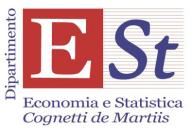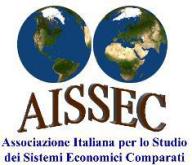Elena Paglialunga, Andrea Coveri and Antonello Zanfei[*]
Introduction
Relatively scanty research exists on the impact of climate change on economic disparities within countries. Accordingly, we explore the links between changes in climate conditions and within-country inequality and stress the relevance of some key structural factors conditioning the ability of the economies to deal with climate events. Two distinctive features of our work are worth mentioning. First, we focus on the agriculture sector, as it is one of the most important channels through which climate change might affect inequality. This emphasis on the agricultural channel highlights that emerging and least developed economies are the most vulnerable to the negative impacts of climate change – even though they have contributed less to climate change itself. Second, we use data on foreign direct investments (FDIs) to assess the role of the economic diversification across global value chain (GVC) activities as an important mediating factor affecting countries’ ability to react to climate change-induced inequality.
By combining different data sources, we construct an original dataset covering more than 150 countries, including a large number of Least Developed Countries (LDCs), over the period 2003-2017, that allows us to empirically investigate these relationships.
Exploring the climate change-inequality nexus: the agricultural channel
Climate change affects both between- and within-countries inequality. As regards the ‘between’ dimension, the uneven distribution of climate damages reflects the different exposure of economic systems to climate-related risks, and their capacity to adapt. Poorer and LDCs are more likely to be negatively affected since they are mostly located at low latitudes where additional climate variability would be particularly harmful, and because of their economic structure (Diffenbaugh & Burke, 2019). It follows that LDCs also have to pay the higher price for adaptation, recovery and redevelopment, while being the least equipped to deal with such changes, due to limited resources (Vallino, 2016).
Recent studies have shown that the effect of climate change on between-country inequality is intertwined with the within-country dimension, as its impacts are heterogeneous across population groups, with poor people being more deeply affected (Hallegatte & Rozenberg, 2017). This suggests the emergence of a vicious cycle, as the most disadvantaged social groups are also the most vulnerable to climate change because of their higher dependence on natural resources, larger exposure to extreme climate conditions and lower adaptive capacity (Angelsen & Dokken, 2018). For example, poorer households often live in marginalized areas, which are more exposed to natural disasters and climate-induced diseases, and, at the same time, might not afford health insurance or lack access to medical facilities (with the most dramatic consequences arising in developing countries) (Castaneda et al., 2018).
In this context, extant literature suggests that agriculture is among the main channels through which climate change affects poverty and economic inequality, especially in LDCs (Rao et al., 2017). On the one hand, climate change may result in negative effects on the income of farmers, with more pronounced impact on rural income in developing countries (Dell et al., 2014). On the other hand, climate change tends to increase food prices, producing harmful consequences especially in LDCs where the share of households’ income dedicated to food consumption is higher (Bandara & Cai, 2014). In addition, climate change may reduce labour productivity and lead to output losses, mainly in the agriculture sector (Day et al., 2019). Accordingly, our analysis of climate change induced inequality will account for the share of population living in rural areas and for the employment in the agricultural sector.
Economic, technological and institutional drivers of inequality and the role of GVCs
Other divers of income disparities must be kept into account when exploring climate change-inequality nexuses.
First, the impact of economic and technological development has received a considerable attention in extant literature on income inequality. Our analysis accounts for these drivers by controlling for different measures such as GDP per capita and its square, industry share of value added, the share of population living in rural areas, and the share of population having access to electricity (Kuznets, 1955; Young, 2013; Castaneda et al., 2018). In addition, the skill- and capital-biased character of technological change makes the latter a crucial determinant of income disparities (Autor et al., 1999) and proxies of it are also included in our investigation. Second, we control for the role of institutions, as they define countries’ capability to effectively respond to adverse phenomena (including climate-related extreme events) and to provide social safety nets for different segments of population (Sarkodie & Strezov, 2019). Finally, economic globalization, in terms of both trade and capital account openness, is likely to impact on income distribution by fostering skill-biased technological change and by affecting the bargaining power of labour with respect to capital (Feenstra & Hanson, 1996; Rodrik, 1997). Accordingly, we also account for the modern GVC-driven international fragmentation of production, paying special attention to the role of (inward) FDIs and their dispersion across value chain activities in shaping distributional dynamics (Gereffi et al., 2005; Antràs, 2019). Building on Hartmann et al. (2017) – who show that the economic diversification of the productive structure of a country is a key driver of its pattern of income inequality – we suggest that the functional specialization induced by the rise of GVCs can unfold at the detriment of a more equal distribution of income, while a greater GVC diversification (defined as a higher dispersion of FDIs across value chain activities[1]) maybe help the process of structural upgrading of receiving economies, with beneficial effects on income distribution.
In addition, we suggest that a higher GVC diversification may play a positive role in increasing the economic resilience of countries by reducing the vulnerability to adverse phenomena (Pike et al., 2010) and making conversion of domestic production easier in case of artificial disasters or climate-induced extreme events. In other terms, we argue that a more balanced participation of economies in GVCs might constitute an alleviating factor of the adverse consequences of climate change on income inequality (Birthal & Hazrana, 2019).
Results of the empirical analysis
Figure 1 provides a graphical representation comparing the country-average (2003-2017) of income inequality, in terms of Gini index from SWIID database (panel a), to the Notre Dame Global Adaptation Initiative (ND-GAIN) index (panel b). The ND-GAIN is an indicator of climate vulnerability constructed such that a higher value indicates that a country is less vulnerable to climate change, i.e. the higher the value, the more resilient the country is. By comparing panel a and panel b in Figure 1 (and as summarized in panel c), we observe that countries characterized by higher level of income inequality (larger value of the Gini index) are also the most vulnerable to climate change (lower value of the ND-GAIN index).
Figure 1. Gini index and ND-GAIN index
(a)
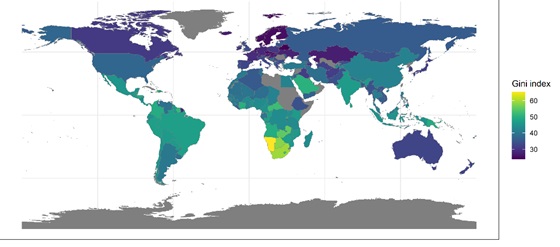
(b)
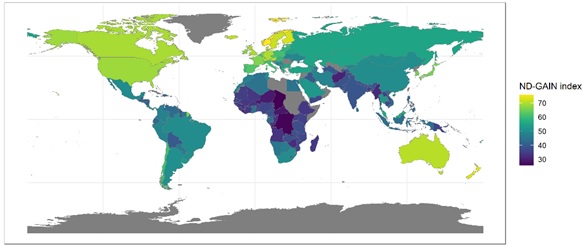
(c)
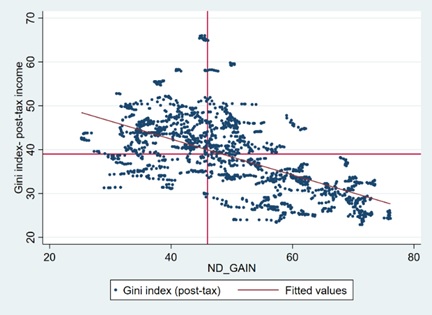
Source: authors’ elaboration on SWIID and ND-GAIN data. In graphic (c), axis x and axis y indicate respectively the scorings of ND_GAIN and Gini index of studied countries.
We summarize here the results we obtained using regression techniques to empirically explore the correlation between climate change and inequality illustrated in Figure 1, controlling for different confounders and mediating factors (details are available in Paglialunga, Coveri & Zanfei, 2020). To do so we built our climate variables using monthly data on temperature and precipitation and calculated indicators signaling the existence of a warming trend, of drying/flooding anomalies, and whether a country has been hit by extreme events[2]. We further controlled for the main determinants of economic inequality, country and time fixed effects to identify the impact of climatic variations on within-country income distribution.
Our estimation results show that both temperature increase and precipitation anomalies have a strong and statistically significant effect in worsening income inequality. We also find that the impact of temperature increases on income distribution is stronger in the presence of high shares of population living in rural areas and of workers employed in the primary sector, hence confirming the importance of the agricultural channel through which climate change affects income distribution.
Moreover, we find that opening economies to foreign capital flows might exacerbate inequality in some circumstances, especially when the insertion of countries in GVCs as captured by inward FDIs goes hand in hand with the hyper-specialization in selected GVC functions. Conversely, the diversification across value chain activities of incoming cross-border investment flows – allowing an increasing sophistication and economic complexity of local economies’ production structure – emerges as a resilience-enhancing factor which results negatively associated with within-country inequality.
Conclusions
According to the IPCC report (IPCC, 2014), catastrophic consequences will be triggered inasmuch as average global temperature will be allowed to exceed 1.5°C – or, at worst, 2°C – pre-industrial levels. The dramatic effects of environmental degradation have already manifested in diverse forms, such as heat extremes, heavy precipitations, droughts, rising sea levels, floods, mudslides, water scarcity and biodiversity losses, with corresponding impacts on health, livelihoods, food security, water supply, and human security (Markandya et al., 2017). As a matter of fact, Eckstein et al. (2018) estimate that the consequences of extreme climate events have amounted to $174 billion (PPP) per year on average from 1998 to 2017 in terms of global economic losses.
Extant evidence also suggests that the impact of climate change is heterogeneous between-countries, with LDCs and poor regions suffering the highest costs. However, few studies have explicitly addressed the impact of climate-related events on within-country inequality, although the latter is the dimension that has deteriorated the most in last decades (Milanovic, 2016).
Based on an original dataset covering more than 150 countries over the period 2003-2017, we have shown that countries characterized by higher level of income inequality (larger value of the Gini index), are also the most vulnerable to climate change (lower value of the ND-GAIN index). Empirical results permit to further explore the climate change-inequality nexuses. Controlling for a large number of determinants of inequality detected by the literature, we find that climate-induced influence on income inequality is stronger in rural areas, which is consistent with higher levels of exposure to climate risks.
We also find that while inward FDIs per se induce a more unequal distribution of income, cross-border investments in most upstream functions of the value chain foster the creation of better-paid jobs and tend to reduce income inequality. Finally, the evidence provided shows that a more even distribution of FDIs across value-adding activities contributes to reduce inequality and alleviate the worsening impact that climate change exerts on income distribution by increasing the economic resilience of countries to external shocks, including environmental-related extreme events.
Given the adverse impact that climate change consequences have on individual income distribution, it is important to stress that the burden of climate mitigation should not fall disproportionally on the poorest segments of population. In other words, climate mitigation policies should be designed in a way that does not determine additional income disparities on top of the dismal effects of climate change.
References
Angelsen, A., Dokken, T. 2018. Climate exposure, vulnerability and environmental reliance: A cross-section analysis of structural and stochastic poverty. Environment and Development Economics, 23(3), 257-278.
Antràs, P. 2019. Conceptual Aspects of Global Value Chains. NBER Working Papers, no. 26539.
Autor, D. H., Katz, L. F., & Krueger, A. B. 1999. Computing inequality: Have computers changed the labor market? Quarterly Journal of Economics, 113 (4), 1169–214.
Bandara, J. S., & Cai, Y. 2014. The impact of climate change on food crop productivity, food prices and food security in South Asia. Economic Analysis and Policy, 44(4), 451-465.
Birthal, P. S., & Hazrana, J. 2019. Crop diversification and resilience of agriculture to climatic shocks: Evidence from India. Agricultural Systems, 173, 345-354.
Castaneda, R.A., Doan, D.D.T., Newhouse, D.L., Nguyen, M.C., Uematsu, H., & Azevedo, J.P. W.D. (2018). A new profile of the global poor. World Development, 101, 250-267.
Day, E., Fankhauser, S., Kingsmill, N., Costa, H., & Mavrogianni, A. 2019. Upholding labour productivity under climate change: an assessment of adaptation options. Climate policy, 19(3), 367-385.
Dell, M., Benjamin, F. J., & Benjamin, A. O. 2014. What Do We Learn from the Weather? The New Climate–Economy Literature. Journal of Economic Literature, 52(3), 740–98.
Diffenbaugh, N. S., & Burke, M. 2019. Global warming has increased global economic inequality. Proceedings of the National Academy of Sciences, 116(20), 9808-9813.
Eckstein, D., Marie-Lena, H., & Winges, M. 2018. “Global Climate Risk Index 2019: Who suffers most from extreme weather events? Weather-related loss events in 2017 and 1998 to 2017”. Briefing Paper. Bonn and Berlin: Germanwatch e.V.
Feenstra, R. C., & Hanson, G. H. 1996. Globalization, Outsourcing, and Wage Inequality. American Economic Review, 86(2), 240–5.
Gereffi, G., Humphrey, J., & Sturgeon, T. 2005. The governance of global value chains. Review of International Political Economy, 12(1), 78–104.
Hallegatte, S., Rozenberg, J. 2017. Climate change through a poverty lens. Nature Climate Change, 7, 250–56.
Hartmann, D., Guevara, M. R., Jara-Figueroa, C., Aristarán, M., & Hidalgo, C. A. 2017. Linking economic complexity, institutions, and income inequality. World Development, 93, 75-93.
IPCC. 2014. Climate Change 2014: Impacts, Adaptation, and Vulnerability. Contribution of Working Group II to the Fifth Assessment Report of the IPCC, Part A. Cambridge University Press: Cambridge (UK and USA).
Kuznets, S. 1955. Economic growth and income inequality. American Economic Review, 45(1), 1-28.
Markandya, A., Paglialunga, E., Costantini, V., & Sforna, G. 2017. Global and Regional Economic Damages from Climate Change. In Oxford Research Encyclopedia of Environmental Science. Oxford: Oxford University Press.
Milanovic, B. 2016. Global inequality: A new approach for the age of globalization. Cambridge: Harvard University Press.
Paglialunga E., Coveri A., & Zanfei A. 2020. Climate change and inequality in a global context. Exploring climate induced disparities and the reaction of economic systems. XXI AISSEC Conference, Urbino University, 8-9 October.
Pike, A., Dawley, S., & Tomaney, J. 2010. Resilience, adaptation and adaptability. Cambridge Journal of Regions, Economy and Society, 3, 59–70.
Rao, N. D., van Ruijven, B. J., Riahi, K., et al. 2017. Improving poverty and inequality modelling in climate research. Nature Climate Change, 7, 857–862.
Rodrik, D. 1997. Has Globalization Gone Too Far? Washington, DC: Institute of International Economics.
Sarkodie, S. A., & Strezov, V. 2019. Economic, social and governance adaptation readiness for mitigation of climate change vulnerability: Evidence from 192 countries. Science of The Total Environment, 656, 150-164.
Vallino, E. 2016. Environmental challenges in the emerging economies: differing perspectives. In Newsletter of the OEET – Turin Centre on Emerging Economies, no. 3, May 2016.
Young, A. 2013. Inequality, the Urban–Rural Gap, and Migration. Quarterly Journal of Economics, 128(4), 1727–1785.
[*] The authors are all from the Department of Economics, Society, and Politics, University of Urbino ‘Carlo Bo’. This short paper summarizes the conceptual framework and the main findings of a research contribution (Paglialunga, Coveri & Zanfei, 2020) they presented at the 2020 AISSEC Conference.
[1] We classify the FDIs activities according to three GVC stages: upstream (e.g. R&D, Design, Education & Training, ICT); production (e.g. Manufacturing, Extraction); downstream (e.g. Business Services, Logistics, Distribution).
[2] Monthly data on temperature and precipitation has been taken from Climatic Research Unit, University of East Anglia.







